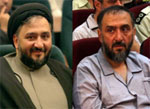Simultaneous Trial for One Hundred Individuals
» Reformists Accused of Fomenting Unrest
The sudden and hasty trial of more than one hundred prominent reformist leaders and other post-election detainees began yesterday at the Tehran Bureau of Justice’s conference hall (Imam Khomeini complex), though it was announced previously that only twenty detainees will be present at Saturday’s session.
Mohsen Mirdamadi, Behzad Nabavi, Mohsen Aminzadeh, Abdollah Ramezanzadeh, Mohammad Ali Abtahi, Mohammad Atrianfar and several other prominent figures and journalists were present at Saturday’s session, which was presided over by Judge Salavati from Branch 15 of the Revolutionary Court. The defendants were accused of conspiring with foreigners and planning to overthrow the Islamic Republic through a velvet revolution.
State Media, Narrators of the Trial
While the Islamic Republic’s news channel yesterday broadcasted only brief moments of the trial (without sound), the Fars news agency, affiliated with the Islamic Passdaran Revolutionary Guards Corps (IRGC), published the litany of charges facing the detainees, who have been behind bars for nearly 50 days without access to lawyers. The majority of the detainees do not have lawyers representing them, as the Tehran prosecutor’s office has prevented attorneys from signing representation agreements with them. The lawyers for other detainees were not allowed into the courtroom. Saleh Nikbakht, who represents several detained activists, was kept behind the court’s closed doors. In return, military and security officers were clearly visible in the courtroom.
The Fars news agency yesterday broadcasted the text of “confessions” by Mohammad Ali Abtahi, former president Khatami’s vice president and Mohammad Atrianfar, central committee member of the Servants of Construction (Kargozaran Sazandegi) Party (close to Hashemi Rafsanjani), though independent sources are uncertain about what exactly the two reformist figures said in court.
Meanwhile, many sources discussed the pale and distraught faces of the detainees, which pointed to their torture and mistreatment. Those present in the courtroom also noted that Abtahi carried a piece of paper with him throughout the session, even reading his confessions from that piece of paper.
Indictment Based on Statements of “a Spy”
The claims of a person identified yesterday as “a spy” formed the basis of the indictment unveiled at yesterday’s session. The spy, who according to the prosecutor “is in detention now after having returned to Iran to take part in the elections” was not identified for “security reasons.” The court quoted the “spy” in describing the structure of and participants in the velvet coup. Although the spy remained unidentified, journalists and analysts believe that the “spy” in question is Iranian blogger Hossein Derakhshan, who returned to Iran several months ago after fundamentally shifting his political views and was later arrested.
The prosecutor’s indictment included a long introduction describing “velvet revolutions,” their goals and strategies as pursued in countries such as Georgia and Kyrgyzstan. The indictment claimed that popular protests (which it referred to as chaos and turbulence) were staged and quoted the aforementioned spy in claiming that the process was carried out with the help of “the three intellectual, media and administrative arms,” which were led by political figures, social, human rights and women’s rights activists, among others.
The indictment accused the detainees of receiving help from international institutions such as the Soros Foundation, the Dutch NGO Hivos, and the U.S. Council on Foreign Relations, staging the conditions for a “velvet revolution” in Iran since before the election.
Charge: Doubting Election’s Health
In another pat of the indictment, similarities between the velvet coup in Iran and several other countries were described, and the three reformist parties, meaning the Islamic Iran Participation Front [Hezbe Mosharekat Iran Eslami], Servants of Construction [Kargozaran Sazandegi] and Association of Combatant Clergy [Mahma’e Rohaniyoon Mobarez] were charged with “cooperation with media and groups hostile and opposed to the regime in order to shed doubt on the election results.”
Tehran prosecutor’s representative accused the three parties of taking part in “staging and administering a velvet coup in Iran,” adding, “The second point of similarity between the Iranian velvet coup with those in aforementioned countries is the widespread and illegal assembly and street protests, which is meant as a practice in training to overtake important government centers. Staging rallies in front of the Interior Ministry, radio and television building and the Islamic Republic Majlis must be assessed from this perspective.”
Kayhan: Reformists are Corrupters on Earth
Hardliner Kayhan daily, which published editorials in line with yesterday’s indictment, attacked Mir-Hossein Mousavi and Seyyed Mohammad Khatami in its front-page headline, writing, “Evidence of Mousavi and Khatami’s Treason Revealed.” The daily referred the court indictment and what has been published as the confessions of the detainees as evidence of Mousavi and Khatami’s treason. The daily’s editor-in-chief, Hossein Shariatmadari, accused the reformists leaders of charges punishable by death in the paper’s main editorial, writing, “The leaders of the chaos are perfect cases of ‘Mofsed fel-Arz’ [‘corrupters on earth, a charge carrying the death penalty in Islamic law], whose unforgivable crimes include the murder of innocent people, destruction of people’s peace, and cooperating with foreign enemies.” Therefore, the trial and punishment of the mid-level leaders of the conspiracy, although necessary, cannot be the end of the matter for the dear authorities. If the main leaders of the conspiracy, who are not unknown, are not seriously confronted, the trial and punishment of mid-level leaders can create a save haven for them to continue their conspiracy.”


